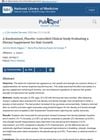Search
forProducts matching "androgenic effects"
Tracking 11 products like 278 Mane Regain - RU58841 5% Solution, 116 REGROWTH M5 NO PG, 150 Brintop F Topical Solution, 151 Tugain 5 Solution (Minoxidil 5%) and 178 Hair4u 10% from by companies like Amazon, Minoxidil Express, Inhouse Pharmacy and ReliableRxpharmacy. View all 11 products »
Sort by
Research
330-360 / 1000+ results
research Effects of Sex Steroid Deprivation and Administration on Hair Growth and Skin Sebum Production in Transsexual Males and Females
Hormone treatments in transsexual individuals reduce hair growth and oil production in male-to-females and increase them in female-to-males.

research A Response to 'Male Balding Is a Major Risk Factor for Severe COVID-19'
The authors suggest that scalp hair might protect against COVID-19 and call for more research on scalp health and the virus.
research Randomized Clinical Trial to Evaluate the Effect of Probiotic Intake on Androgenic Alopecia
Probiotics help reduce hair loss and increase hair growth in people with androgenic alopecia.

research Oral Minoxidil Therapy in Hair Loss: Where Do We Stand?
Oral minoxidil is effective for various hair loss types and may improve male sexual function, but aspirin can reduce its effectiveness.

research Dermatologic Side Effects of Systemic Targeted Anticancer Therapy
Cancer treatments targeting specific cells often cause skin, hair, and nail problems, affecting patients' lives and requiring careful management.

research Effects of Allium Hookeri Extracts on Hair-Inductive and Anti-Oxidative Properties in Human Dermal Papilla Cells
Allium hookeri extract may help promote hair growth and protect cells from damage.
research Different Synaptic Stimulation Patterns Influence Local Androgenic and Estrogenic Neurosteroid Availability Triggering Hippocampal Synaptic Plasticity in Male Rats
The availability of certain hormones and specific stimulation patterns affect long-term synaptic changes in the male rat brain.

research The Efficacy of Using Platelet-Rich Plasma in the Treatment of Androgenic Alopecia: A Literature Review
PRP therapy helps improve hair growth and is safe for treating hair loss.

research How I Treat Alopecia in Patients with Cancer
Dermatologists should carefully manage hair loss in cancer patients to improve their quality of life.

research Effects of Finasteride on Vascular Endothelial Growth Factor
Finasteride reduces prostate bleeding by affecting blood vessel growth.

research Effects of Multiple Plasma Donations on Donors’ Biochemical Parameters
Multiple plasma donations do not change donors' biochemical parameters.

research 5α-Reductase Inhibitors: Evaluation of Their Potential Confounding Effect on GC-C-IRMS Doping Analysis
5α-reductase inhibitors can interfere with doping tests by masking banned substances.

research Morroniside Regulates Hair Growth and Cycle Transition via Activation of the Wnt/β-Catenin Signaling Pathway
Morroniside may help hair grow and stay in its growth phase by affecting certain cell signals.

research Hair Growth-Promoting Effects of Astragalus Sinicus Extracts in Human Follicle Dermal Papilla Cells
Astragalus sinicus extracts may help promote hair growth and treat hair loss.

research The Differences Between Aromatizable And Non-Aromatizable Androgens In Relation To Body Composition And Metabolic Syndrome Risk Factors In Men
Testosterone and dihydrotestosterone have similar effects on body composition and metabolic health in men.

research Effects on Steroid 5-Alpha Reductase Gene Expression of Thai Rice Bran Extracts and Molecular Dynamics Study on SRD5A2
Thai rice bran extracts, especially from Tubtim Chumphae rice, can significantly reduce the activity of hair loss genes, with x-tocopherol showing potential as an anti-hair loss product.

research The Hydroxypropyl-β-Cyclodextrin-Minoxidil Inclusion Complex Improves the Cardiovascular and Proliferative Adverse Effects of Minoxidil in Male Rats: Implications in the Treatment of Alopecia
A new gel form of minoxidil is equally effective for hair growth and safer for the heart and other organs than the traditional solution.

research A Randomized, Placebo-Controlled Clinical Study Evaluating a Dietary Supplement for Hair Growth
The supplement improved hair density and was safe to use.

research Effects of Chronic Inhibition of Testosterone Metabolism on Cardiac Remodeling After Ischemia/Reperfusion-Induced Myocardial Damage in Gonadectomized Rats
Testosterone reduces heart damage and inflammation after injury.

research Androgenetic Alopecia: Effects of Oral Finasteride on Hormone Profile, Reproduction, and Sexual Function
Finasteride safely treats hair loss without harming hormones or reproduction, but may slightly reduce sexual function.

research Effects of Non-Contingent Cocaine on 3alpha-Androstanediol: Disruption of Male Sexual Behavior
Cocaine impairs male sexual behavior and alters testosterone metabolism in the brain.

research Contemporary Medical Therapy for Polycystic Ovary Syndrome
New treatments for PCOS focus on insulin resistance and reducing testosterone levels, along with traditional hormone therapies.

research Hair, Cutaneous Homeostasis, and Stem Cell Functions
Proteins like aPKC and PDGF-AA, substances like adenosine and ATP, and adipose-derived stem cells all play important roles in hair growth and health, and could potentially be used to treat hair loss and skin conditions.

research Role of Androgens in Female-Pattern Androgenetic Alopecia, Either Alone or Associated with Other Symptoms of Hyperandrogenism
Androgens significantly affect female hair loss, and hormonal treatments may help.

research MicroRNA Species in Follicular Fluid Associating With Polycystic Ovary Syndrome and Related Intermediary Phenotypes
Certain microRNAs in the fluid around eggs are linked to Polycystic Ovary Syndrome and may help diagnose it.
research Ursolic Acid Reduces Prostate Size and Dihydrotestosterone Level in a Rat Model of Benign Prostatic Hyperplasia
Ursolic acid can shrink the prostate and lower a hormone linked to prostate growth in rats.

research Steroid Hormones of Reproduction and Sexual Development
Sex hormones affect reproduction, sexual development, and oral health, and it's important for dental practitioners to understand their effects and interactions.

research KY19382, A Novel Activator of Wnt/β-Catenin Signalling, Promotes Hair Regrowth and Hair Follicle Neogenesis
KY19382 helps regrow hair and create new hair follicles.